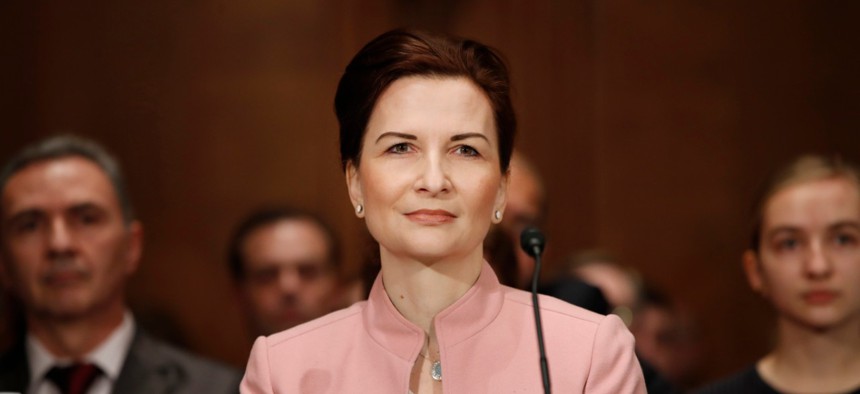
FDIC Chairwoman Jelena McWilliams said the move is partly intended to reduce layers of management. Jacquelyn Martin/AP file photo
FDIC to Offer Separation Incentives to One-Fifth of Its Workforce
Agency says effort is not a cost-cutting move, though it is also closing field offices.
The Federal Deposit Insurance Corporation is planning to shed staff by offering separation incentives to one-fifth of its workforce, the agency announced on Thursday.
Officials said the early retirement and buyout offers going out to 1,200 employees do not represent a cost-cutting measure, but instead are intended to reduce layers of top-level management while redistributing resources elsewhere. The government corporation is also reducing its physical footprint, however, closing five field offices and consolidating two more.
“Today’s announcement is part of a deliberate strategy to further reduce layers of management, acquire new skillsets, and allow the agency to proactively address succession planning prior to any crisis or emergency situation,” said FDIC Chairwoman Jelena McWilliams. “This program will enhance our agility, preparedness and technological transformation.”
FDIC examiners, who ensure banks are safe and sound for operation, will not receive separation offers. Officials told reporters Thursday they had no concerns the reductions would negatively impact any core examination or enforcement efforts.
Officials were adamant the measures were not intended to cut costs. Some divisions may end up hiring more employees than the number who leave, they said. Officials said two workforce reviews over the last year revealed a high rate of retirement eligibility among the top ranks and the initiative would help flatten out FDIC's workforce to make it less top heavy. They added it was a rare opportunity to make reforms as the banking industry is currently in good shape.
“This program is not designed to reduce the FDIC budget or the overall size of the workforce,” the agency said in a statement. “Indeed, the agency remains focused on retaining and growing its examination and risk-related workforce, as well as adding specialized information technology, computer science, data management, and loan review skills at various levels throughout the agency.”
FDIC does not have a specific acceptance rate target in mind, but, with some exceptions, anticipates being able to handle everyone agreeing to leave who receives the offers. The initiative is not a reduction in force and all participation is voluntary.
Executive and mid-level employees accepting buyouts will receive six months of pay, while certain administrative and clerical workers will receive a full year’s salary. Employees will be notified of their eligibility over the next two weeks and must let FDIC know of their decision by May 4. Most employees will leave between May 9 and June 6, with some exceptions for critical positions or when more time is necessary for knowledge transfer.
Tony Reardon, president of the National Treasury Employees Union, which represents front-line FDIC employees, expressed concern impacted workers would not have enough time to make decisions. He also said the union would bargain over fallout from the office closures.
“We also intend to closely examine the FDIC’s justification for these decisions, and our union will raise concerns if we feel the moves are unwarranted or harmful to FDIC’s ability to accomplish its mission,” Reardon said.
Officials said the field office reductions were being made in response to the reduced footprint of financial institutions.
This story was updated to reflect clarification from an FDIC official who initially misspoke when discussing the program, and to include comment from the National Treasury Employees Union.







